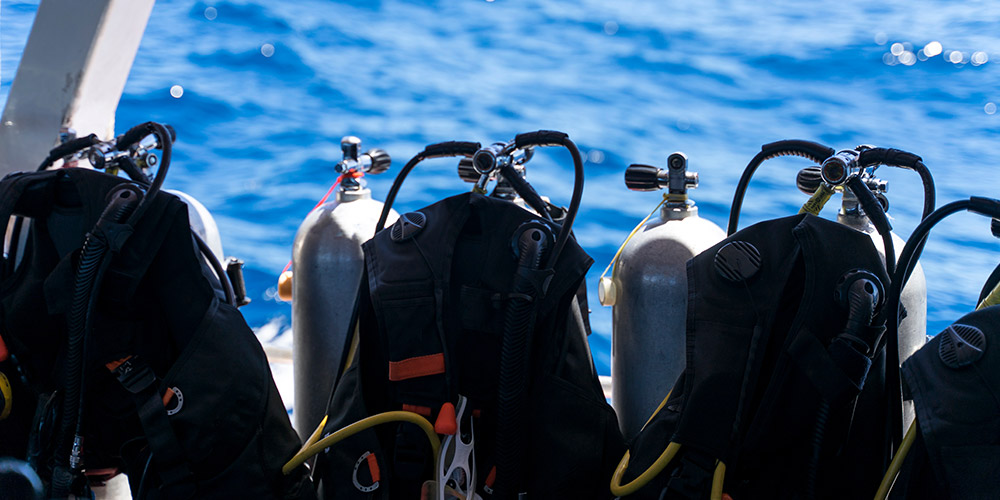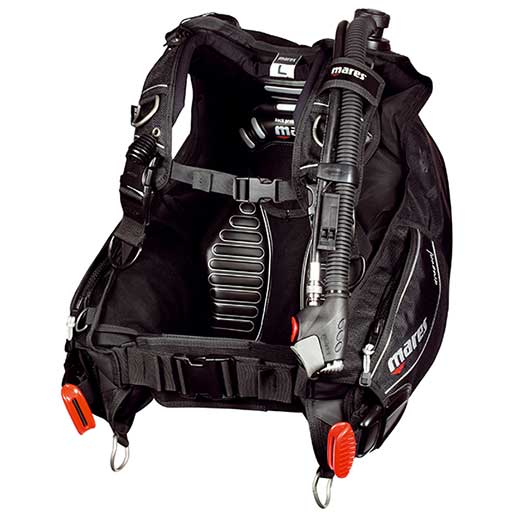

Experienced divers know that buoyancy control is paramount to a relaxing and successful dive. The purpose of a BCD (Buoyancy Compensating Device) is to help divers control their buoyancy at the surface, while descending, at depth and during ascents. Properly used, a diver’s BCD helps to make him or her neutrally buoyant—with the associated feeling of weightlessness that makes diving the pleasure that it is. It also provides a mount for your tank.
Adding air to a BCD increases buoyancy, while releasing air decreases buoyancy. At the beginning of your dive, you’ll use your BCD as a flotation device at the water’s surface. Utilizing accessible ports, you will release air from your BCD to descend to the bottom where you will either add or remove air from the BCD’s bladder to maintain neutral buoyancy during the course of the dive. At the end of your dive, proper use of your BCD will enable you to ascend at a safe rate to the water’s surface again.
Consider the following when selecting a BCD:
1. Which style of BCD: Back-Mount Inflatable or Jacket/Backpack Inflatable?
A back-mounted inflatable BCD has the bladder/air cells located mostly on your back, making it harder to be upright at the water’s surface when fully inflated. A jacket/backpack inflatable BCD’s air cells are located throughout the backpack, giving you more balance at the surface. Regardless of the style, it’s important that a BCD fit snug in order to keep from shifting in the water. Some styles come with an adjustable cummerbund, chest strap and waist strap to keep you comfortable in the water. Other styles are meant for easy traveling and include flat exhaust valves for a tight profile and are usually made of lightweight materials.
2. What is the lift capacity (weight limit) and weight system?
Since one function of a BCD is to lift you to be neutrally buoyant (stay at a consistent depth with minimal effort) in the water it is important to know the lift capacity of a BCD so you can be properly weighted. Heavier and denser divers will need a higher lift capacity to stay afloat. Children and smaller divers will need less lift capacity to stay afloat. During scuba certification, divers will determine if they are naturally one of two buoyancies:
- Positive Buoyancy: you float
- Negative Buoyancy: you sink
Depending on your natural buoyancy, your wetsuit and your equipment determines if you may need more or less lift. For example, a BCD rated with 150lb. lift capacity should not be worn by someone who weighs 200lb. It will not provide enough buoyancy. BCDs with integrated weight systems have pockets for extra lead weights for more positive buoyant divers, which eliminates the need for a weight belt.
3. What is the function of the power inflator hose?
Choose a low-pressure inflator hose that is compatible with your first stage connector (DIN or yoke). Pressure release valves should be easily accessible in order to dump air quickly. An overpressure valve is an extra feature on a BCD that prevents rupture of the bladder, which is particularly important for a heavier/less buoyant diver as it will keep him from having to fin up to the surface using only leg strength.
4. Does the BCD allow for custom configurations for your regulator/octopus, gauges and accessories?
A BCD with adjustable straps keep hoses close to your body for easy access. D-rings allow you to customize how you wear your dive accessories like gauges or spear guns so there is less drag and less opportunity to knock into something. Both straps and D-rings allow you to dive hands-free.